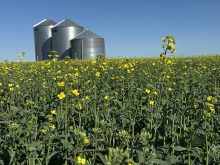Sixteen percent of the 2008-09 chickpea crop was seeded to desis, according to Statistics Canada. Garth Patterson, executive director of Saskatchewan Pulse Growers, wonders if it should be zero.
He asked chickpea panelists at a Pulse Days 2009 market outlook session if it’s time for Canada to give up on desis and focus solely on growing kabulis.
“I think so,” was the response he received from Peter Wilson, manager of global supply chain at JK International Ltd., a major exporter of the crop.
Wilson had just delivered a presentation that touched on how growers in northern Australia were having phenomenal success growing desis, harvesting two tonnes of the crop per acre. But they have the same frustrations growing kabulis that Canadian farmers have growing desis.
Read Also

Huge Black Sea flax crop to provide stiff competition
Russia and Kazakhstan harvested huge flax crops and will be providing stiff competition in China and the EU.
“If you want a chickpea program in Canada, I’d be focusing very heavily on the small kabulis and B-90s and Chicos and the large kabulis, because it seems to fit,” Wilson told Patterson.
In his presentation, Wilson told growers that chickpea prices should remain “relatively attractive” in 2009 due to continued strong demand from the Indian subcontinent and the weakened Canadian dollar.
“By and large it’s going to be steady as she goes,” he said.
But he cautioned growers to keep a close eye on Pakistan. It has become a high-risk destination with the global economic crisis.
“If they continue to be going through their turmoil, then that’s going to have a big impact on the desi market and the small B-90s,” said Wilson.
Growers are going to feel the brunt of any continued market risk stemming from the financial crisis.
“The only way exporters can manage their risk is to buy as cheaply as they possibly can,” Wilson said.
Marlene Boersch, managing partner of Mercantile Consulting Venture Inc., said Spain is another market to watch. It is a major buyer of quality kabuli chickpeas but it has been hard hit by Europe’s financial crisis.
Credit problems are emerging with established buyers in that country.
“It’s certainly exacerbating the slowdown in the kabuli market,” said Boersch.
Kabulis generally account for one million tonnes of the eight million annual world chickpea production. The remainder is desis.
India produces about three-quarters of the world’s chickpea crop but despite an 11 percent increase in chickpea subsidies in 2007-08, the crop still ranked fourth in terms of returns per acre.
The upshot is that pulse production has been stagnant and India will remain an important importer of Canadian pulses.
But there is one area of concern.
“We have new competition on kabulis coming from India,” Boersch told growers.
While the Asian country remains an important importer of desis it has recently become an exporter of kabulis.

















